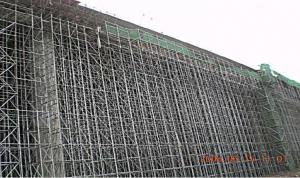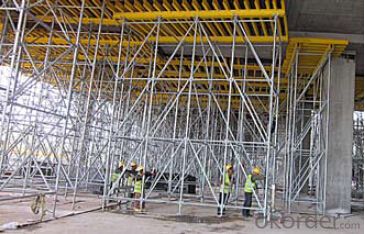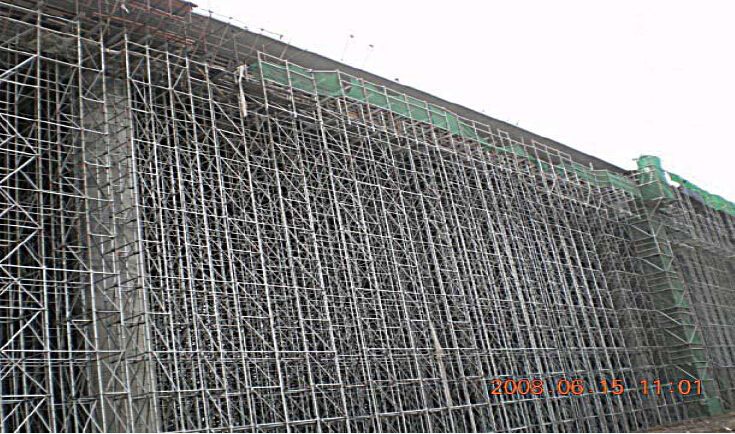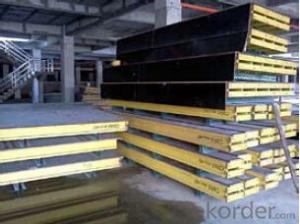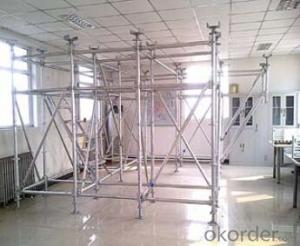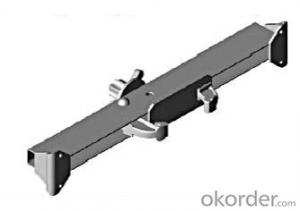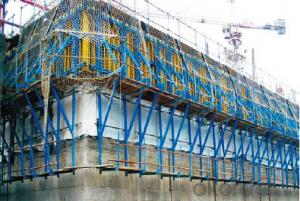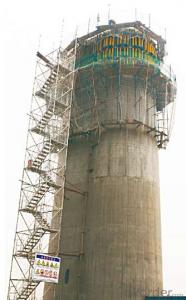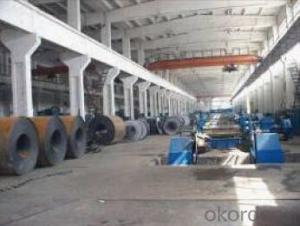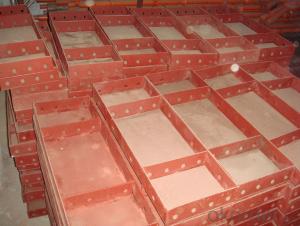Tower scaffolding for formwork and scaffolding system
- Loading Port:
- Tianjin
- Payment Terms:
- TT OR LC
- Min Order Qty:
- 50 m²
- Supply Capability:
- 1000 m²/month
OKorder Service Pledge
Quality Product, Order Online Tracking, Timely Delivery
OKorder Financial Service
Credit Rating, Credit Services, Credit Purchasing
You Might Also Like
Tower Scaffolding
Shoring tower is an effective supporting system. It is easy to assemble and dismantlement, and
has excellent stability and bearing capacity. It has been widely used in the construction of industry
& residential buildings , bridges, tunnels and dam project, etc.
Characteristics:
◆ High degree of standardization.
◆ Easy storage and transportation
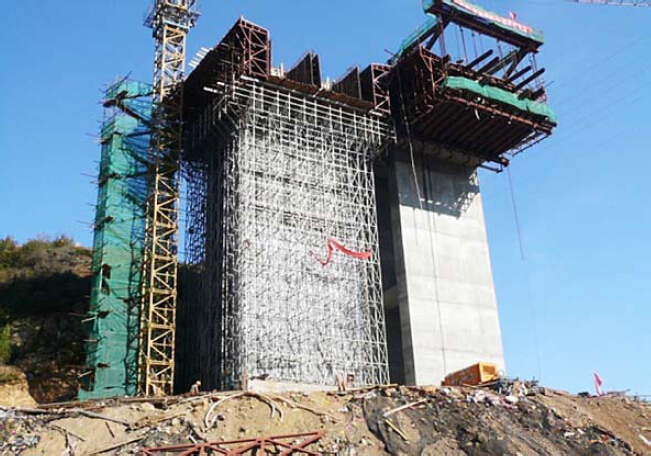
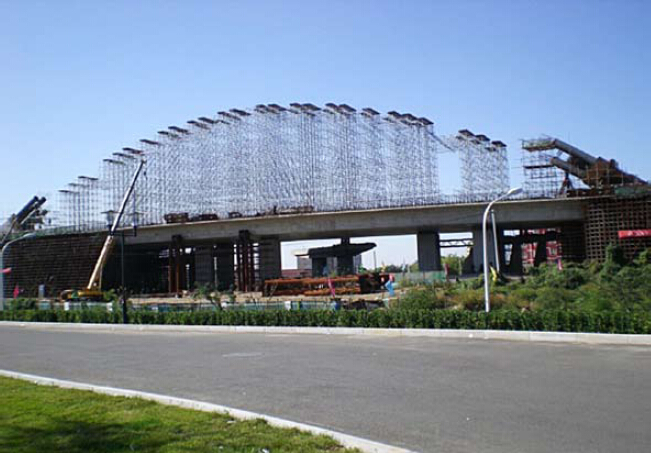
- Q: Can steel formwork be used for both interior and exterior structures?
- Yes, steel formwork can be used for both interior and exterior structures. Steel is a versatile and durable material that can withstand various weather conditions and is suitable for use in both indoor and outdoor environments. It provides excellent strength and stability, making it an ideal choice for constructing structures such as walls, columns, slabs, and beams. Additionally, steel formwork is reusable, which makes it cost-effective and environmentally friendly. Whether it is for interior or exterior construction, steel formwork offers a reliable and efficient solution.
- Q: How does steel formwork perform in seismic zones?
- Due to its high strength and durability, steel formwork is an excellent choice for seismic zones. The robustness of steel enables it to withstand the intense shaking and vibrations caused by earthquakes, as it has outstanding load-bearing capacity and resistance to bending and shearing forces. During an earthquake, seismic zones experience significant ground movement, which exerts immense pressure on the formwork system. However, steel formwork remains rigid and strong, preventing any significant deformation or damage. This ensures the stability and integrity of the structure both during and after the seismic event. Furthermore, steel formwork provides flexibility in design and construction, allowing for reinforced concrete structures that can better handle seismic loads. Additional reinforcement elements, such as steel bars and mesh, can be incorporated with the use of steel formwork, enhancing overall strength and ductility. This helps dissipate the energy generated by seismic forces and reduces the risk of structural failure. In addition to its performance, steel formwork is also cost-effective and sustainable in seismic zones. It can be easily dismantled and reassembled, making it reusable and facilitating quick repair and reconstruction in the event of earthquake damage. This minimizes downtime and ensures the safety of occupants. In conclusion, steel formwork is a reliable and resilient choice for construction in seismic zones. Its strength, durability, and flexibility make it well-suited to withstand the forces generated by earthquakes, ensuring the safety and stability of structures in these high-risk areas.
- Q: How is steel formwork installed?
- Steel formwork is installed in a systematic and efficient manner to ensure accurate and sturdy construction. The process typically involves the following steps: 1. Planning and preparation: Before installing steel formwork, careful planning and preparation are essential. This includes determining the desired shape and dimensions of the concrete structure, calculating the required amount of steel formwork panels and accessories, and ensuring all necessary tools and equipment are available. 2. Site preparation: The construction site needs to be prepared adequately. This involves clearing the area of any debris or obstacles, leveling the ground, and ensuring a solid foundation. 3. Positioning and alignment: Steel formwork panels are positioned and aligned according to the planned structure. This is done by connecting and securing the panels using various methods, such as clamps, nuts, bolts, or pins. It is crucial to ensure proper alignment and tightness to prevent any leakage or seepage of concrete. 4. Reinforcement installation: If required, steel reinforcement bars are installed within the formwork to provide additional strength and support to the concrete structure. These reinforcement bars are precisely placed according to the structural design and secured firmly to the formwork panels. 5. Formwork bracing: To ensure stability and prevent any deformation during the pouring and curing of concrete, steel formwork needs to be adequately braced. Bracing helps distribute the load evenly and maintain the desired shape of the structure. Horizontal and vertical bracing systems are used to provide the necessary support and rigidity. 6. Pouring and compacting concrete: Once the steel formwork is securely in place and braced, concrete is poured into the formwork. The concrete is then compacted using vibrators or other suitable equipment to remove any air bubbles and ensure proper adhesion and density. 7. Curing and removal: After the concrete is poured and compacted, it needs to be cured to achieve maximum strength and durability. Curing can be done by various methods, such as covering the structure with plastic sheets or water spraying. Once the concrete has sufficiently cured, the steel formwork can be removed carefully, starting from the top and gradually moving downwards. It is important to note that the installation process may vary depending on the specific project requirements, complexity of the structure, and the type of steel formwork used. Therefore, it is always advisable to consult with experienced professionals or engineers to ensure proper installation and adherence to safety standards.
- Q: How does steel formwork handle different concrete curing methods?
- Steel formwork is highly versatile and can handle different concrete curing methods effectively. Its strength and durability enable it to withstand the pressures exerted by various curing techniques, such as traditional wet curing, steam curing, and precast curing. Steel formwork provides a stable and rigid structure that can maintain the shape of the concrete during the curing process, regardless of the method used. Additionally, steel formwork can be easily adjusted, dismantled, and reassembled, making it suitable for different curing methods and allowing for efficient construction processes.
- Q: Can steel formwork be used for both simple and complex architectural designs?
- Yes, steel formwork can be used for both simple and complex architectural designs. Steel formwork offers excellent strength and durability, allowing it to handle complex shapes and intricate details with ease. It can be easily assembled and disassembled, making it suitable for various design requirements. Additionally, steel formwork provides a smooth and uniform finish, ensuring high-quality results for both simple and complex architectural designs.
- Q: How does steel formwork handle different concrete durability requirements?
- Steel formwork is highly versatile and can easily handle different concrete durability requirements. It provides a reliable and durable framework for concrete casting, ensuring consistent and precise results. Steel formwork can withstand the pressure of fresh concrete without deforming, which is essential for achieving the desired shape and finish of the concrete structure. Additionally, steel formwork can be easily adjusted and reused, making it suitable for various construction projects with different durability requirements. Whether the concrete needs to withstand heavy loads, extreme weather conditions, or have a longer service life, steel formwork can efficiently accommodate these requirements and help in achieving the desired durability of the concrete structure.
- Q: What are the considerations when designing steel formwork for bridges?
- When designing steel formwork for bridges, there are several considerations to take into account. Firstly, the load capacity of the formwork must be determined, ensuring that it can support the weight of the wet concrete and any construction equipment. Additionally, the formwork should be designed to withstand the forces generated during the pouring and curing of the concrete, such as lateral pressure and vibration. The formwork system should also be easy to assemble, disassemble, and adjust to accommodate different bridge geometries and dimensions. It is important to consider the durability and corrosion resistance of the steel used in the formwork, as bridges are often exposed to harsh environmental conditions. Finally, the design should incorporate safety measures, such as guardrails and access platforms, to ensure the safety of workers during construction.
- Q: What are the different accessories required for steel formwork maintenance?
- The following are the various accessories needed to maintain steel formwork: 1. To maintain the smooth surface of the formwork and prevent corrosion or damage, formwork cleaning agents are used to remove any concrete residue or build-up on the steel formwork. 2. Prior to pouring concrete, formwork release agents are applied to the steel formwork to prevent it from sticking. This makes it easier to remove the formwork once the concrete has cured. 3. Formwork patching compounds are used to fix any damages or imperfections on the steel formwork. This helps maintain the formwork's structural integrity and ensure its longevity. 4. To ensure smooth operation and prevent friction or wear and tear, formwork oil or grease is applied to the moving parts of the steel formwork, such as hinges or sliding mechanisms. 5. Formwork ties and connectors are used to secure the formwork panels together during concrete pouring, ensuring stability. They should be regularly inspected and replaced if damaged or worn out. 6. Formwork wedges and pins are used to align and secure the formwork panels in place. Regular checks should be done to ensure proper positioning and stability. 7. Formwork clamps and brackets are accessories used to support and hold the formwork panels in position. They should be inspected for any signs of damage or weakness and replaced if necessary. 8. To clean the steel formwork and prevent the accumulation of dirt or debris, formwork cleaning tools such as brushes, scrapers, and high-pressure washers are used. 9. Racks, trolleys, or storage containers are used as storage and transportation equipment for the steel formwork. Proper storage and transportation ensure the formwork's longevity and prevent any damage or distortion. In summary, the various accessories needed for steel formwork maintenance are essential for optimal performance, durability, and safety during concrete construction projects.
- Q: Can steel formwork be used for water retaining structures?
- Yes, steel formwork can be used for water retaining structures. Steel formwork is known for its strength, durability, and ability to withstand high pressures. When properly designed and constructed, steel formwork can provide a watertight seal and effectively resist the hydrostatic pressure exerted by water. Additionally, steel formwork allows for a smooth and uniform finish, reducing the risk of water leakage. However, it is essential to ensure proper waterproofing measures are in place, such as using appropriate sealing materials and techniques, to prevent any potential water leakage or seepage through joints or connections. Regular inspection and maintenance are also necessary to ensure the long-term integrity of the water retaining structure.
- Q: Can steel formwork be used for both flat and sloped concrete surfaces?
- Yes, steel formwork can be used for both flat and sloped concrete surfaces. Steel formwork is highly versatile and can be easily adjusted and shaped to accommodate different angles and slopes during the concrete pouring process. Its strength and rigidity make it suitable for supporting the weight and pressure of the concrete, ensuring a smooth and uniform finish regardless of the surface inclination.
Send your message to us
Tower scaffolding for formwork and scaffolding system
- Loading Port:
- Tianjin
- Payment Terms:
- TT OR LC
- Min Order Qty:
- 50 m²
- Supply Capability:
- 1000 m²/month
OKorder Service Pledge
Quality Product, Order Online Tracking, Timely Delivery
OKorder Financial Service
Credit Rating, Credit Services, Credit Purchasing
Similar products
Hot products
Hot Searches
Related keywords

